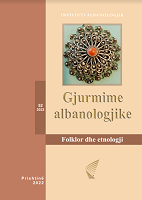“BESA-BESË” - FLUIDITETI I KONOTIMIT TË KËNGËS NË KONTEKST (SUB)NACIONAL
“BESA BESË” FLUIDITY OF SONG CONNOTATION IN SUB-NATIONAL CONTEXT
Author(s): Lumnije KadriuSubject(s): Customs / Folklore, Music, Culture and social structure , Social Theory, Sociology of Culture, Sociology of Politics, Sociology of Art, History of Art
Published by: Instituti Albanologjik i Prishtinës
Keywords: Besa - Besë; Lulja me erë/Fragrant flower; R. Sokoli;
Summary/Abstract: The folk song titled “Besa - Besë” was initially a lyrical song titled “Lulja me erë/Fragrant flower” and was composed by a prominent Albanian ethnomusicologist R. Sokoli from Shkodra during 1940s. This song is recently most recognizable as a song marking Kosovo Football Representation and their fans named “Dardans”. The path from being a love song to a song representing Kosovo Football Club is quite complex as is the history of Kosovo Albanian People. Therefore, in the first part of this paper, which is mainly based on the work of Kosovo ethnomusicologist Rexhep Munishi, as well as other historical books related to Kosovo, is explored how Kosovo Albanian audience has used and transformed the text of this once lyrical love song in different historical contexts relevant for their national awareness and mobilization, including the context of sports and “Plisa”, i. e. fans of Football Club Prishtina. In addition to this the second part of the paper is focuse again on the song Besa Besa but now mainly used in the context of sports, identification and nationalism. This way in these two parts are juxtaposed different theoretical standpoints on nation research; in the first one events could be explained as essentialist and ethno-national (Anthony D. Smith) based interpretations of national awareness, while in the second part will come to prominence constructivist (Benedict Anderson) interpretation of national building as well as new “cognitive turn” in nation research (Rogers Brubaker) in which is also included a sub-national concept (Michael Billig). So, by trying to explore and find out: What are the changes in the song? What are the contexts in which it is used? How was it used by different artists/singers? How is it used interchangeably by rivalling fans? What is the role of media and advertising? How and when national and sub-national connotations are intertwined?, is facilitated better nderstanding of this song’s fluidity over time.
Journal: Gjurmime Albanologjike - Folklor dhe etnologji
- Issue Year: 2022
- Issue No: 52
- Page Range: 79-107
- Page Count: 29
- Language: Albanian
- Content File-PDF

